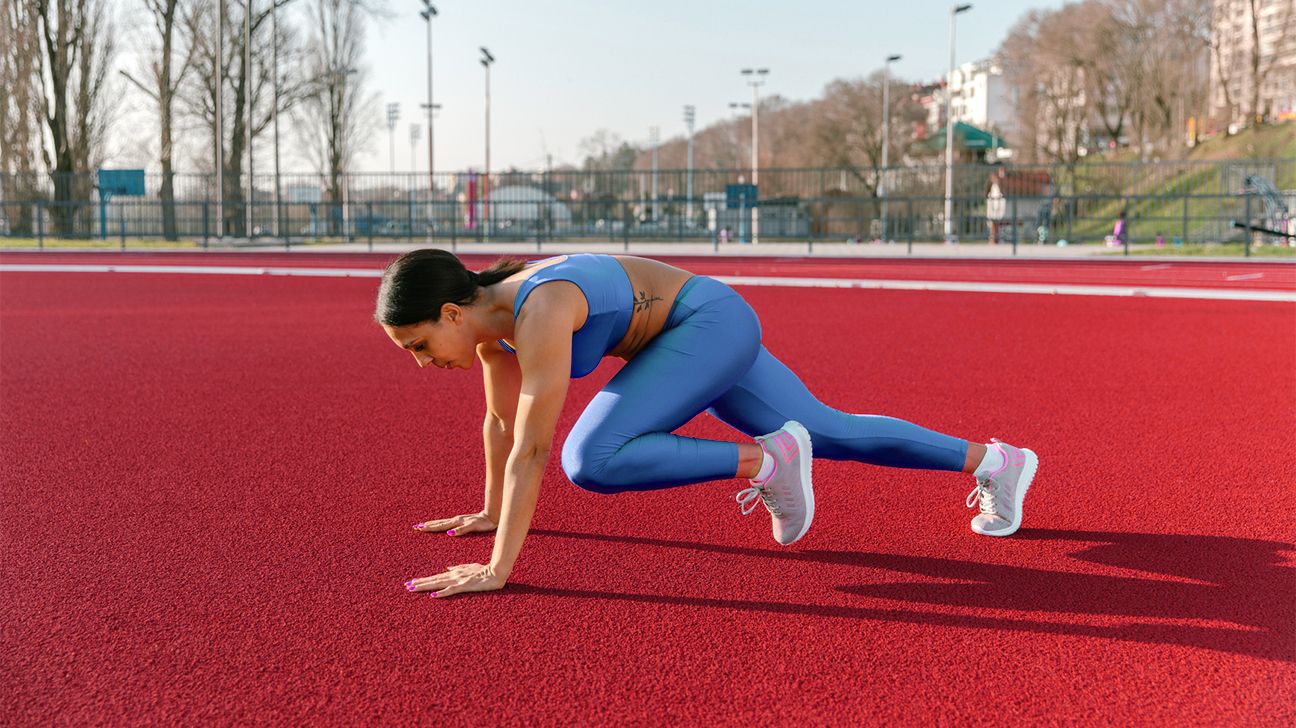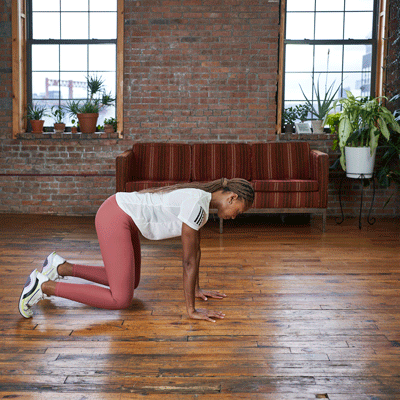The bear crawl — not to be confused with a bear claw donut — is a bodyweight mobility exercise. It’s a killer core workout that’s also bear-y beneficial for the butt, back, hips, quads, and shoulders.
Here’s how (and why) you should add this challenging workout to your fitness routine.

Here’s a step-by-step guide to help you bring your inner bear to life:

- Begin in a tabletop position with hands under your shoulders and knees under your hips.
- Tuck your toes and lift your knees until they’re about 1–2 inches off the ground.
- Pull your core up toward your spine without lifting your hips and keep your gaze straight in front of you.
- Bring your right hand and left foot forward in unison. The space between your arms and legs should be equal.
- Switch sides and repeat.
P.S. Roaring is optional 🐻.
There’s a reason why the bear crawl is a staple in boot camp, Spartan, CrossFit, and other high intensity workout routines. The bear crawl can help increase strength, stability, mobility, and stamina all at once. Here’s a rundown of some of the best benefits.
- Good for overall fitness. A 2021 study of recruit firefighters found that a 7-week high intensity functional training (HIFT) regimen improved body mass index (BMI), cardiovascular fitness, and muscular endurance. Note: While this study included bear crawls, other exercises were also performed.
- Full-body exercise. Bear crawls are great if you want to target the core and shoulders. But you’ll also get a great workout in your chest, back, butt, quads, and hamstrings.
- No equipment needed. You can do bear crawls at the gym, at home, or on-the-go without the use of machines or equipment. All you need is your body and some floor space.
- Better balance. Since bear crawls can increase core strength, they might also help enhance balance and posture. Just keep in mind, we need more studies on bear crawls alone to prove these perks. Core stability training might also reduce your risk of injury, according to a 2013 study.
Classic bear crawls are a top-notch workout. But if you want to spice it up, there are tons of variations to keep things fresh and fun. Here are seven to start with.
- Slow or fast bear crawl. You’ll perform the same motions as the classic bear crawl, but switch up the speed. The fast bear crawl adds an extra layer of cardio intensity while the slow version can help to target the hip flexors and thoracic spine.
- The arm and leg lift and hold. Bear crawls are all about moving your opposing arms and legs in unison. You can build on this coordination by holding this position for your desired duration. Then lower back down to the floor, switch sides, and repeat.
- Low bear crawl. This variation is awesome for arm strength. You bring your body a bit lower to the ground and bend the elbows. It’s great for working those arm muscles, as it relies more on your triceps than skeletal structure for support.
- Straight leg bear crawl. This one is bomb for your butt 💣🍑. As you can tell by the name, this crawl requires you to straighten your legs. You’ll perform a basic bear crawl, but with locked knees and extended legs.
- Sideways bear crawl. The name says it all. Instead of walking forward you go sideways. Two notes though. First, make sure to stick to the alternating arm and leg pairing. Second, repeat the crawl on both sides. You’ll only work half your muscles if you only go one way.
- Weighted bear crawl. Time to bring some equipment into the mix. Lots of peeps like using a weighted vest. Experienced bear crawlers can place a weighted plate on their backs. PSA: This requires a ton of strength and balance, so you need to be uber careful.
- Uneven bear crawl. Bear crawling on uneven surfaces is a fantastic mobility challenge. The more uneven the terrain, the more challenging the crawl.
The bear crawl requires a lot of strength, balance, and coordination. That said, a lot can go wrong. Here are some tips to keep your workout safe and effective.
- Engage your core and keep your spine aligned.
- Wear shoes that don’t slip and have a great grip.
- Keep your hips lateral to take stress off your core.
- Don’t push past your limits. It increases your risk of injury.
- Avoid more challenging variations until you’ve mastered the original.
- Start with small steps until you build up more stamina for bigger motions.
Bear crawls work the entire body, but you’ll see the most benefits in your core and shoulders. There are tons of variations that can help you target specific muscles. You can also tweak the pace and direction you move for a tougher challenge.
Just keep in mind, the bear crawl is an intermediate exercise. So, it’s 10/10 important to know your limits and maintain proper form. This can greatly reduce your risk of injury and makes the workout more effective.

